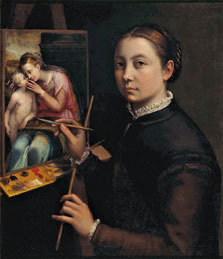Heroines
dal 7/3/2011 al 4/6/2011
Segnalato da
7/3/2011
Heroines
Museo Thyssen-Bornemisza, Madrid
This exhibition is interested in images which could be sources of "empowerment" for women themselves. This exhibition is also a kind of "city of ladies" centred especially on the cycle of modernity, from the 19th century to the present day. Following a non-chronological but thematic order, it explores the backgrounds and aspirations of heroines: the iconography of solitude, work, delirium, sport, war, magic, religion, reading and painting. On view to Museo Thyssen-Bornemisza and Fundacion Caja Madrid.

The exhibition Heroines looks at the depiction of women in active roles and at the gender identity crisis in western art. It covers a broad chronological span, from the Renaissance to the present day. In western art, women have all too often been reduced to two prevailing, complementary models; that of mother or that of the object of sexual desire. Other, parallel roles have, however, arisen, in which the female figure has liberated herself from a passive, submissive position in order to become an active subject. Such roles include hunting and athletics exercise, war, political power, and magic and religion, among others.
The history of Western art is full of images of seductive, indulgent, submissive, defeated and enslaved women. But the women whom this exhibition centres on are strong women: active, independent, defiant, inspired, creative, domineering and triumphant. Or, to use a key word that has been at the top of the feminist agenda for the last few decades: this exhibition is interested in images which could be sources of “empowerment” for women themselves. Lists of heroines have a long history, starting with the first catalogues of famous females by Hesiod and Homer, in which women appeared only as “accessories” to the males – as the heroes’ or gods’ mothers and daughters, wives and mistresses.
The first compendium of women who were illustrious on their own merit was that in Boccaccio’s De claris mulieribus, which followed in the footsteps of Petrarch’s De viris illustribus.
Inspired by Boccaccio’s work but intent on correcting his point of view, in 1405 Christine de Pizan wrote the first defence of women to be penned by a woman: The Book of the City of Ladies. Pardon the anachronism but Christine de Pizan was the first feminist – because she attributed the disadvantages of being a woman not to Mother Nature but to force of habit. Her book led to a long Querelle des Femmes which has lasted seven centuries and is still very much alive.
This exhibition is also a kind of “city of ladies” centred especially on the cycle of modernity, from the 19th century to the present day. Following a non-chronological but thematic order, it explores the backgrounds and aspirations of heroines: the iconography of solitude, work, delirium, sport, war, magic, religion, reading and painting. In each “chapter” artworks from different periods, languages and artistic environments are juxtaposed, providing food for thought on what has changed through those differences and what has remained the same. And in each chapter, one or several voices of women artists, particularly contemporary women, respond to images created by their male counterparts.
The exhibition’s last chapter is dedicated to images created by women before a mirror, to the development of the self-portrait by female painters from Sofonisba Anguissola to Frida Kahlo. The self-portrait allowed women to be both the author or creator (a supposedly male role) and the model (the conventional female role). This cunning combination of activity and passivity, of being the painter without abandoning the role of the beautiful subject was the key to the success of the female self-portrait in a patriarcal society; a society in which, furthermore, Vanity was always personified as a woman looking at herself in the mirror. Some women, however, have often portrayed themselves as male colleagues would have done – in working clothes, holding a palette and paintbrushes, and looking out at the spectator. This kind of selfportrait, which we might describe as the “masculine” type, seems to have been cultivated more regularly by female painters, perhaps because they needed to justify themselves as professionals more than men.
Catalogue
On sale at the reception desk of the Fundación Caja Madrid exhibition space.
Image: Sofonisba Anguissola, Self-Portrait Painting the Madonna, 1556. Oil on canvas, 66 x 57 cm. Muzeum Zamek w Łańcucie, Lancut
Museo Thyssen-Bornemisza
Paseo del Prado, 8. 28014 Madrid
Opening times
Tuesdays to Sundays, 10am to 7pm. Closed on Mondays. Closed 1 May. Visitors are asked to leave the galleries 5 minutes before closing.
Ticket Prices:
-Thyssen Bornemisza Coll.: 8.00 €
-Heroines exhibition: 8.00 €
-Combined ticket for Thyssen Bornemisza Collections and Heroines exhibition: 13.00 €
Fundación Caja Madrid
Plaza de San Martín, 1. 28013 Madrid
Opening hours
Tuesdays to Sundays, 10am to 8pm. Closed on Mondays. Closed 1 May
Free entry



